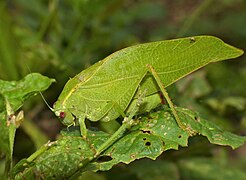An Introduction to the Katydids:
Katydids are a close relative of the Locust and belong to the order of insects called Orthoptera. They may closely resemble grasshoppers but are more leaf-like. They are known by other names as well such as the Bush Cricket or even the Long-horned Grasshopper.

Places where you can spot Katydids:
You may find them hiding in the bushes or grass. When it comes to specific environments they live in but are not limited to:
They can be found in Forests (tropical) if you go to South America. In the US they usually reside in Deserts.
Physical Appearance:
They are quite big and reach a length of in between 0.5 Inches to 2.5 approximately for some of the common variant. However, there is one variant known that grows twice that called the Predatory Bush Cricket.
Generally the species have a green coloration to them but other colors have been seen such as yellow and even pink.
As like other grasshopper relatives; Katydids have wings as well. Usually long, their wingspan reaches 10 inches across. One thing to note is that these wings aren’t always used for flight alone.
Distribution and importance:
Katydids can be found in every habitable continent around the world where other insects live. They can be observed at places ranging from the Amazon Rainforest to other places with a high density of flora.
Katydids have a habit of concealing themselves in places where they can camouflage themselves.
They live in places that have their own set of seasons. Some species (that live in the cold) have limited lifespans of about a year or less which allows them to breed only once. Other species living in warmer climates live for quite a few years.
The egg laying behavior of species also varies. Some prefer to lay them on top of plants while others prefer laying them on soil.
The diets of Katydids also vary with most of them being herbivorous and a few species are carnivores.
They also use their array of colors of defense to scare off predators telling them that they might not be palatable or to hide in the brush. They show signs of aposematism where they deter potential predators by coloration to show that they may have noxious or toxic chemicals in them.

Male Katydids are known as the prime producers of sound with them habitually letting out mating calls. Every species has it’s own unique sound. Every call or sound has a distinct purpose be it aggressive, territorial or for mating.
The role of Katydids in Cooking:
Katydids like other insects are considered quite nutritious and for some cultures quite delectable. After cleaning them, you can cook them up in a skillet or wok like a stir-fry. You can just season them and fry them in general or even roast them. phentermine prescription online ohio https://waldofleamarket.com/ phentermine online in texas
Katydids are often seen as snacks too with them being packaged and sold in various parts of the United States.
When preparing them you can pair them with seasonings such as cayenne pepper, paprika, onion or garlic powder and even sauces like soy or worcestershire sauce.
Just keep in mind to remove the legs and the wings as well before cooking.
The Medicinal Uses of Katydids:
It’s relative the grasshopper has been noted to be made into tea to treat asthma and other ailments. In contrast Katydids have also been used to fight medical ailments such as liver disorders, ulcers and anaemia.
Health and Safety:
Katydids may have noxious chemicals that they use in defensive. Be cautious when handling and preparing them before cooking.
Also keep in mind if you have any allergies that may be related to insects or any allergies in general before handling Katydids.
Species like Katydids are at times also host to various parasites as well like tapeworms and more. Cooking them through and through is key but you still have to keep this in mind.
They also have quite a nasty bite for insects of their size, be vary of that as well.
Many of our readers find that subscribing to Eat The Planet is the best way to make sure they don’t miss any of our valuable information about wild edibles.
var gCaptchaSibWidget;
var onloadSibCallback = function() {
var element = document.getElementsByClassName(‘sib-default-btn’);
gCaptchaSibWidget = grecaptcha.render(element[0],{
‘sitekey’ : ‘6Ld5UPEhAAAAAC8Ax6SnRJ8wjEg9yV3xNmVZZtSZ’,
‘callback’ : sibVerifyCallback
});
};
https://www.google.com/recaptcha/api.js?onload=onloadSibCallback&render=explicit

Leave your email address so you don’t miss any of our wild edibles info!
.email-input { margin-bottom: 10px; width:100%; border:2px solid #aaa; border-radius:4px; outline:none; padding:16px; box-sizing:border-box; transition:.3s; } .email-input:focus { border-color:dodgerBlue; box-shadow:0 0 8px 0 dodgerBlue; } .sub-button-style { padding: 10px; border-radius: 5px; background-color: #162115; border: none; color: #f7f7f7; width: 100%; }form#sib_signup_form_2 p.sib-alert-message {
padding: 6px 12px;
margin-bottom: 20px;
border: 1px solid transparent;
border-radius: 4px;
-webkit-box-sizing: border-box;
-moz-box-sizing: border-box;
box-sizing: border-box;
}
form#sib_signup_form_2 p.sib-alert-message-error {
background-color: #f2dede;
border-color: #ebccd1;
color: #a94442;
}
form#sib_signup_form_2 p.sib-alert-message-success {
background-color: #dff0d8;
border-color: #d6e9c6;
color: #3c763d;
}
form#sib_signup_form_2 p.sib-alert-message-warning {
background-color: #fcf8e3;
border-color: #faebcc;
color: #8a6d3b;
}
Like our facebook page for additional articles and updates.
![]() Follow us on Twitter @EatThePlanetOrg
Follow us on Twitter @EatThePlanetOrg
See our privacy policy for more information about ads on this site






